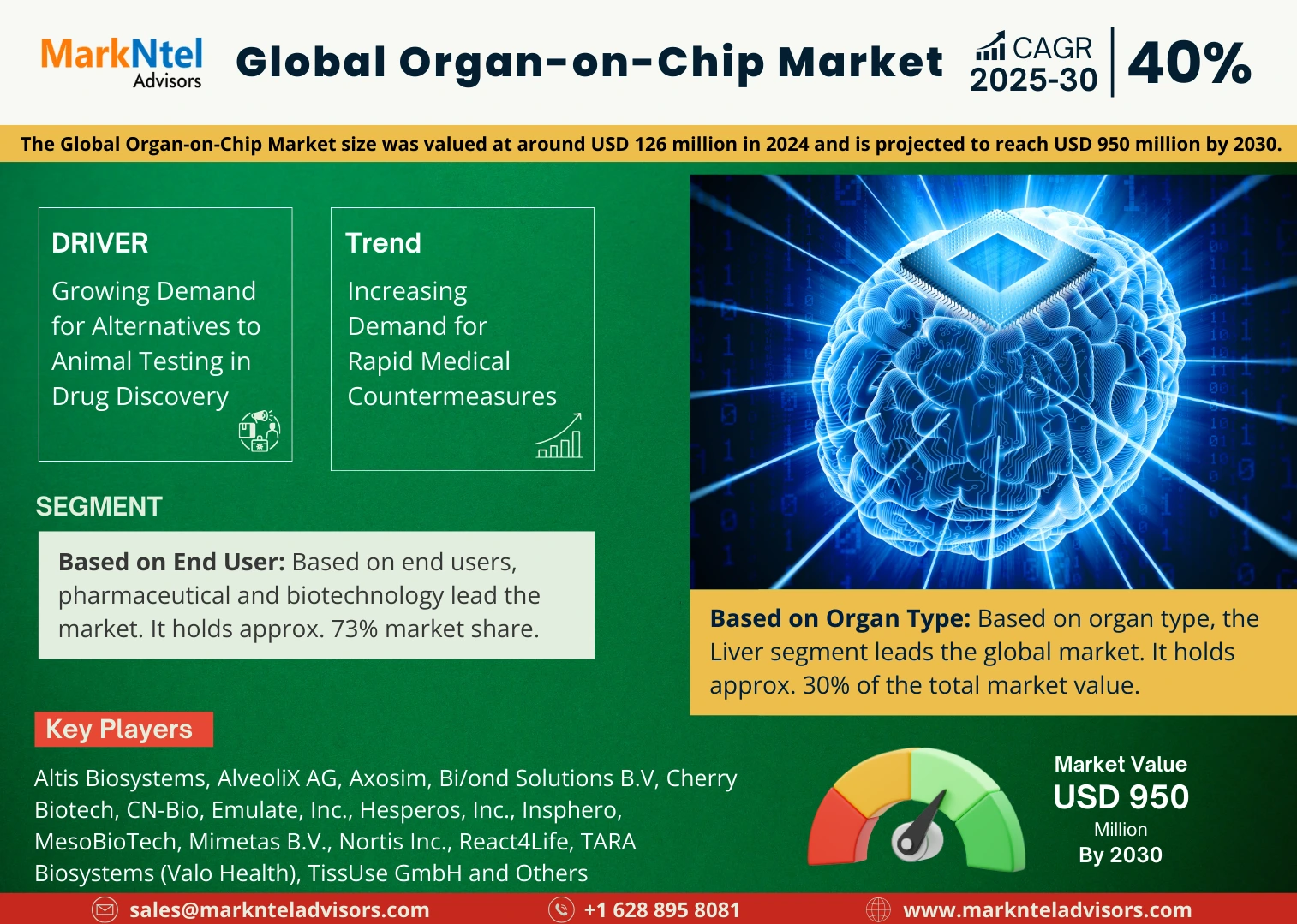Press Release Description
With an Estimated CAGR of 40%, Global Organ-on-Chip Market to Reach USD950 Million Mark by 2030
The Global Organ-on-Chip Market size was valued at around USD 126 million in 2024 and is projected to reach USD 950 million by 2030. Along with this, the market is estimated to grow at a CAGR of around 40% during the forecast period (2025-30), cites MarkNtel Advisors in the recent research report. Various factors are attributed to the market's growth. Regulatory and ethical pressures are compelling the acceptance of Organ-on-chip technology as it provides more accurate, human-relevant data while minimizing reliance on animal testing. Advances in microfabrication and 3D printing have furthered the development of complex, organ-specific models, which in turn has boosted their application in pharmaceutical research. Governments and private entities are making significant investments in Organ Chip technology to accelerate drug discovery and enhance success rates. It is geared toward patients' biology and supports the development of personalized treatment regimens, making them much more useful.
Apart from drug testing, they are now penetrating cosmetics testing, environmental toxin screening, and disease modeling. Growing collaborations between academic institutions, startups, and pharma companies are creating innovative momentum and fast-track commercialization. Moreover, multisystem models of organs exhibiting complex biological interactions are found to be more in line with systemic disease research studies. Additionally, using artificial intelligence increases predictive potential through optimized experimental design and improved results. Research efforts toward cost-effective and scalable production of Organ-On-Chips are taken to meet the needs for high-throughput testing demands.
Although some factors can drastically affect the market growth. High development costs and complex manufacturing processes limit the technology's widespread adoption, especially for small-scale firms. The lack of standardized protocols makes it difficult to compare different Organ on Chips systems, which in turn delays regulatory acceptance. Scalability is a major issue because most of the current models are not suitable for high-throughput testing. In addition, limited awareness and expertise in using organ-on-chip technology in emerging markets slows its penetration. The integration of multidisciplinary knowledge in biology, engineering, and materials science is necessary but challenging, further states the research report “Global Organ-on-Chip Market Analysis, 2025.”

Segmentation Analysis
Liver-On-Chips Generate Maximum Market Demand
Based on organ type, the market is further bifurcated into Liver, Intestine, Kidney, Lung, Heart, and others. Out of them, the liver-on-chip leads the market. It holds approximately 30% of the total market volume. This significant share is due to their wide application in studying liver diseases, toxicity testing, and drug metabolism. The liver plays a critical role in drug detoxification and metabolism, making liver-on-chip devices indispensable in pharmaceutical research and preclinical studies. These models effectively replicate the human liver's microenvironment, enabling detailed analysis of drug interactions and toxicological responses. This makes them a better alternative for more accurate and ethical use in place of animal testing. Their use has, therefore, been driven by adoption, especially in the pharmaceutical and biotechnology sectors, as well as academic research environments. In addition, the scalability and functionality of liver-on-chip systems have improved with advances in microfluidic technologies, which further strengthens their market position.
North America Leads the Global Organ-on-Chip Industry
North America leads the Global Organ-on-Chip Market with a market share of around 52%. The region is supported by robust investments in biomedical research, superior infrastructure, and the presence of major industry players. The supportive government policies and ethical mandates to use alternatives to animal testing favor the region. All these factors support the growth of Organ-On-Chips technology adoption in drug discovery, toxicity testing, and personalized medicine. The strong academia-industrial interface in the U.S. and Canada has furthered the development of organ-on-chip models. Both government and private funding on a large scale as well as important research on organ system complexity, such as on chips, for the liver, lungs, and the heart, also support North America. These innovations will continue to make this region the hub for developing and commercializing advanced microfluidic technologies.
Competitive Landscape
With strategic initiatives such as mergers, collaborations, and acquisitions, the leading market companies, including Altis Biosystems, AlveoliX AG, Axosim, Bi/Ond Solutions B.V, Cherry Biotech, CN-Bio, Emulate, Inc., Hesperos, Inc., Insphero, MesoBioTech, Mimetas B.V., Nortis Inc., React4Life, TARA Biosystems (Valo Health), TissUse GmbH, and others are looking forward to strengthening their market positions.
Key Questions Answered in the Research Report
- What are the industry’s overall statistics or estimates (Overview, Size- By Value, Forecast Numbers, Segmentation, Shares)?
- What are the trends influencing the current scenario of the market?
- What key factors would propel and impede the industry across the globe?
- How has the industry been evolving in terms of geography & product adoption?
- How has the competition been shaping up across various regions?
- How have buying behavior, customer inclination, and expectations from product manufacturers been evolving during 2020-30?
- Who are the key competitors, and what strategic partnerships or ventures are they coming up with to stay afloat during the projected time frame?
We offer flexible licensing options to cater to varying organizational needs. Choose the pricing pack that best suits your requirements:
Buy NowNeed Assistance?
WRITE AN EMAIL
sales@marknteladvisors.comCustomization Offered
100% Safe & Secure
Strongest encryption on the website to make your purchase safe and secure
